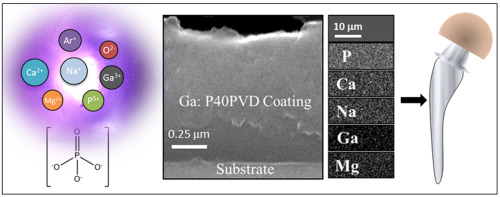GALLIUM INCORPORATION INTO PHOSPHATE BASED GLASSES: BULK AND THIN FILM PROPERTIES
Bryan W. Stuart, Colin A. Grant, George E. Stan, Adrian C. Popa, Jeremy J. Titman, David M. Grant
Index: 10.1016/j.jmbbm.2018.03.041
Full Text: HTML
Abstract

The osteogenic ions Ca2+, P5+, Mg2+, and antimicrobial ion Ga3+ were homogenously dispersed into a 1.45 μm thick phosphate glass coating by plasma assisted sputtering onto CP grade titanium. The objective was to deliver therapeutic ions in orthopedic/dental implants such as hip prosthesis or dental screws. The hardness 4.7 GPa and elastic modulus 69.7 GPa, of the coating were comparable to plasma sprayed hydroxyapatite/dental enamel, whilst superseding femoral cortical bone. To investigate the manufacturing challenge of translation from a target to vapour condensed coating, structural/compositional properties of the target (P51MQ) were compared to the coating (P40PVD) and a melt-quenched equivalent (P40MQ). Following condensation from P51MQ to P40PVD, P2O5 content reduced from 48.9 to 40.5 mol%. This depolymerisation and reduction in the P-O-P bridging oxygen content as determined by 31P-NMR, FTIR and Raman spectroscopy techniques was attributed to a decrease in the P2O5 network former and increases in alkali/alkali-earth cations. P40PVD appeared denser (3.47 vs. 2.70 g cm−3) and more polymerised than it's compositionally equivalent P40MQ, showing that structure/ mechanical properties were affected by manufacturing route.
|
Acute exposure of white-tailed deer cortical bone to Staphyl...
2018-04-04 [10.1016/j.jmbbm.2018.04.003] |
|
Tribological evaluation of biomedical polycarbonate urethane...
2018-04-03 [10.1016/j.jmbbm.2018.04.001] |
|
Mechanical alterations of the bone-cartilage unit in a rabbi...
2018-04-03 [10.1016/j.jmbbm.2018.03.033] |
|
Swelling of Fiber-Reinforced Soft Tissues is Affected by Fib...
2018-04-03 [10.1016/j.jmbbm.2018.03.039] |
|
Material properties of ultra-high molecular weight polyethyl...
2018-04-03 [10.1016/j.jmbbm.2018.03.029] |